Knowing the beautiful films for which Studio Ghibli is famous, it’s no surprise that the company was able to produce breathtaking visuals for Level-5’s latest PS3 RPG, Ni no Kuni. To play this game is to constantly see some of the most pleasant visuals of the current generation. This isn’t so much because of raw spec-maxing power output, but more because these graphics truly capture the spirit of the game, all while looking bright colorful, and full of life. Walking around the game’s various towns and dungeons, and especially the world map, looks amazing 100% of the time. The stunning soundtrack, composed by Ghibli’s go-to music man Joe Hisaishi, helps push the overall presentation into its own league.
The aforementioned overworld is a feature beloved by many JRPG fans, yet absent from a great many newer games. Final Fantasy, for example, featured these in every numbered entry through Final Fantasy IX, yet from X onward, that aspect disappeared. With Ni no Kuni, however, gamers who enjoyed that part of 8, 16, and 32-bit role playing games are really in for something special. Ni no Kuni‘s overworld is wide, sprawling, and features all kinds of terrain. What’s really impressive about it is the elevation changes.
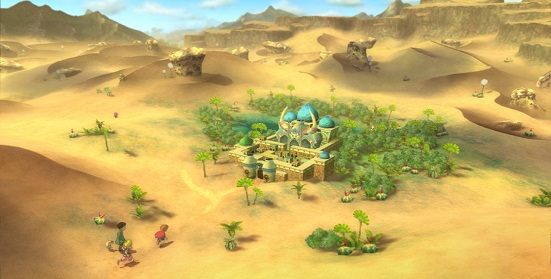
World maps of days gone by were largely flat sheets with features drawn onto them — the mountains could usually not be scaled while still on the map and even then, the specs of the old consoles usually kept such as a functionally 2D experience. Ni no Kuni, however, will have Oliver and company running up slopes, moving around large boulders, descending into valleys, traversing sand dunes, and more. Players will find plenty of reason to explore every last inch of it, with hidden villages, tons of hidden items both visible and invisible, and bounty battles. Exploring the overworld feels like going back to a favorite pastime after years of being away from it. It just feels right, and you wonder why you ever left. Of course, the gorgeous visuals assist in the experience.
Combat is a nice combination of action and turn-based systems. Seasoned RPG vets will have no trouble with it early on, but the challenge gradually escalates over the 40-to-60-hour play time, with an excellent learning curve that — like most things — makes the game highly accessible. Provided that gamers don’t spend a copious amount of time running in circles leveling up beyond what’s sufficient, they’ll consistently find some challenge in the fights. Longtime fans of the genre, be warned that the first few hours of “press X to win” may throw you for a loop, but this game gets tougher. Though, that being said, the combat is fun and the world is such a joy to explore that getting caught up and over-leveling may happen to some people accidentally. The demo currently available on the PSN Store doesn’t even demonstrate the whole system, as more elements – such as the game-changing attack shift and defense shift – aren’t introduced until almost midway through the story. Some players will be 25 or even 30 hours deep before they encounter this twist on the system, which adds another layer of strategy and enjoyment to the already fun battle system.
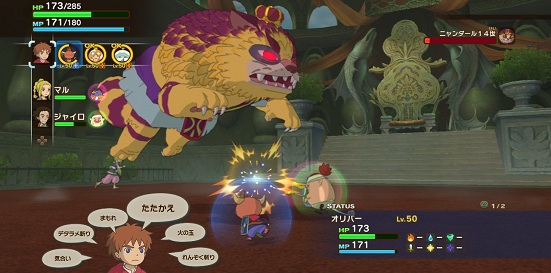
After acquiring a second party member, players can catch monsters called Imajinns in battle, and make them into allies. Human party members can fight for themselves or send in one of up to three Imajinns each; despite their differences in strength and defense, the monsters share HP with the human character who controls them. In addition to the expected ability to raise the Imajinns’ levels by bringing them into combat, players can improve monster stats by feeding them certain foods. Evolution becomes possible after a certain level floor is reached, but players can opt for a more powerful evolution if they hold out and evolve their Imajinn after it gets a little stronger — so you’re trying to prioritize, weighing short term versus the long term, every time you evolve something. Furthermore, the final step of every monster’s evolutionary path is a fork, extending even more choice to the gamer. These types of decisions make the game interesting by adding a lot of variety and possibilities, while also tossing in some replay value. After getting a third human party member, the strength and depth of the battle and growth systems become obvious.
It’s with the evolution, however, that one of the game’s only real flaws can be found. The interface, at some points, could’ve been more streamlined. Having to feed a monster one piece of food, then have to sit and watch while it munches it down…then wait for it to dance in reaction…then hit the button again…then watch that cycle all over again gets old. Succeeding in an RPG is all about maximizing your opportunities and getting the most from your limited resources, so experienced players will likely be feeding their Imajinns several pieces of food at a time. On paper, this is efficient. And yet in practice, it’s not, because the feeding process is stupidly slow. Similar gripes can be applied to the awkward monster storage system and item crafting (whose interface takes a bit too long to become functional). These are somewhat minor hangups, and the fact that these are the game’s biggest downfall actually stands as testament to its overall quality.
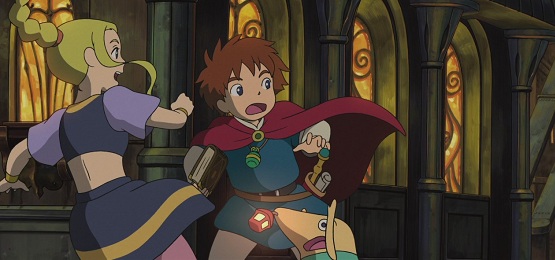
Ni no Kuni‘s story is a well-told tale of a young boy trying to undo the death of his mother. Main character Oliver and his companions act, speak, and otherwise conduct themselves in believable ways. There’s a certain campy sound to a lot of JRPG dialogue, and Ni no Kuni is largely free from this. Oliver talks and acts like a real kid would; his mother talks and acts like a mother might; his magical companion has the same accent as my magical companion (sshh). Some might roll their eyes a few times in the early going, but the story does a great job of providing an interesting reason to keep going for players of all ages.
The cast has great chemistry and the writing is surprisingly solid. There are a few moments that feel like they were forced in as little more than an excuse to show off more of the pretty graphics, but overall, Level-5 did an impressive job putting together a collection of characters that really compliment each other.
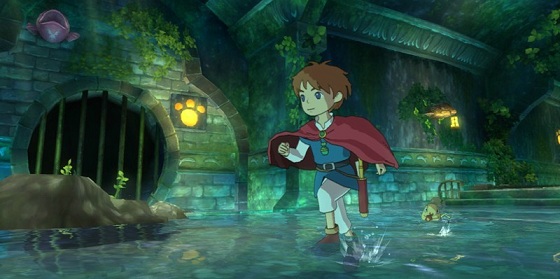
Due to its aesthetics and main character, there will inevitably be discussions of how “kiddy” the game is, and already we’ve seen the word “childish” pop up, which is an inappropriate description of the game. One thing to note is the difference in the connotations of childish versus childlike. Beavis and Butthead is childish, whereas Spirited Away is childlike. There’s also a huge difference in something being made for children and being enjoyable by children. Care Bears and iCarly are made for children; Spirited Away and Nausicaa can be enjoyed by children. The latter two, however, are far more than just “kids’ movies.” Ni no Kuni is a game you can play with your kids in the room, yes, but that doesn’t take away from the quality of the script and there high level of challenge here. This game — its features and systems — are everything JRPG fans have been wanting.
Permit me to quote my FAQ which says, “Mature content does not equal mature themes. Handguns, the F word, and breasts are not what inherently make a game “mature.” This is a fallacy created by the ESRB rating system which brands a game containing such things as “Mature.” The lack of logic in that naming can be found underneath the giant M, where the label says “17+,” meaning 17-year-olds can buy these games. We all know that 17-year-olds are the least mature creatures on the face of the planet.”
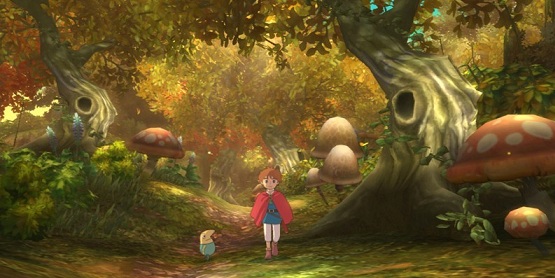
Virtually every aspect of Ni no Kuni is a hit, from its likeable cast to its fun battles; from its inspiring soundtrack to its rewarding exploration; from its imaginative story to the excellent pacing that takes you through it — and this is all ignoring the notion that this is one of the most visually impressive games of the current console generation. It’s a new game built from the best parts of our favorite classics. If you’ve recently wished that the RPGs of today had a little more in common with their elders from the 16 and 32-bit eras — no, wait, check that — if you have ever liked a Japanese RPG at all, you owe Ni no Kuni a shot.
-
Friendly for all ages without being too slanted one way.
-
Fun battles.
-
Delightful soundtrack.
-
World map is beautiful and loaded with content.
-
Artistically speaking, these are the best visuals of the generation, in part thanks to...
-
...Mmm, mmm, those Studio Ghibli cutscenes.
-
Nice twist on monster catching/evolution.
-
Lengthy main quest with plenty of rewarding side quests.
-
North American/European versions come pre-loaded with all the Japanese DLC.
-
Exploring the big towns and talking to the townsfolk feels so perfectly right.
-
This is the natural evolution of the Japanese RPG.
-
Menus should have been a little more streamlined.
-
Lack of negatives is punishing the formatting of my review.




